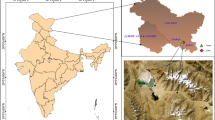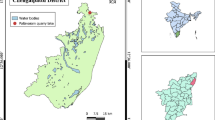Abstract
To investigate vertical changes of bacterial communities from living plants to the associated sediments and bacterial biogeochemical roles in peatland ecosystem, samples of different part of individual Sphagnum palustre and the different layers of the underlying sediments were collected from Dajiuhu Peatland in central China. All samples were subject to 16S rRNA gene clone libraries and quantitive PCR analysis. Even though bacteria vary in abundance at the same order of magnitude in all samples, they show great profile difference in composition from the top part of S. palustre to the low layer of the sediments. Cyanobacteria and alpha-Proteobacteria dominate at the top part whereas Acidobacteria at the middle part of S. palustre. Alpha-Proteobacteria and Acidobacteria are the dominant phyla at the bottom part of S. palustre and in the surface peat sediment. In contrast, bacterial communities in the subsurface sediments are dominated by Acidobacteria. These profile distributions of different bacterial communities are closely related to their ecological functions in the peatland ecosystem. Specifically, most Cyanobacteria were observed at the top green part of S. palustre, a horizon where the active photosynthesis of the moss occurs, which infers their endosymbiosis. In contrast, Acidobacteria, dominant in the subsurface sediments, are able to decompose the specific compounds on the cell wall of Sphagnum moss and thus might play an important role in the formation of the peatland, including the acidic condition. Methane oxidizing process might have been underestimated in Sphagnum peatland due to the identification of Methylocystaceae in all parts of the moss investigated here. The vertical difference in bacterial composition and bacterial ecological functions presented here sheds light on the understanding of biogeochemical processes, in particular the CH4 flux, in peat ecosystems.
Similar content being viewed by others
References
Ausec L, Kraigher B, Mandic-Mulec I. 2009. Differences in the activity and bacterial community structure of drained grassland and forest peat soils. Soil Biol Biochem, 41: 1874–1881
Bao W, Cao J. 2001. Spore germination and sexual reproduction of Sphagnum (in Chinese). Bull Biol, 36: 8–9
Belova S E, Baani M, Suzina N E, et al. 2011. Acetate utilization as a survival strategy of peat-inhabiting Methylocystis spp. Environ Microbiol Rep, 3: 36–46
Bossio D A, Scow K M, Gunapala N, et al. 1998. Determinants of soil microbial communities: Effects of agricultural management, season, and soil type on phospholipids fatty acid profiles. Microbial Eco, 36: 1–12
Bridgham S D, Pastor J, Janssens J A, et al. 1996. Multiple limiting gradients in peatlands: A call for a new paradigm. Wetlands, 16: 45–65
Chao A. 1984. Nonparametric estimation of the number of classes in a population. Scand J Stat, 265–270
Dai Y, Hou X, Wang H, et al. 2012. Seasonal dynamics of microorganism in rhizospheric soil of Artemisia ordosica in Ordos sandy land (in Chinese). J Arid Land Resour Environ, 10: 103–107
Dedysh S N, Pankratov T A, Belova S E, et al. 2006. Phylogenetic analysis and in situ identification of bacteria community composition in an acidic Sphagnum peat bog. Appl Environ Microbiol, 72: 2110–2117
Falkowski P G, Fenchel T, Delong E F. 2008, The microbial engines that drive Earth’s biogeochemical cycles. Science, 320: 1034–1039
Fierer N, Jackson R B. 2006. The diversity and biogeography of soil bacterial communities. Proc Natl Acad Sci USA, 103: 626–631
Gibbon B C, Kropf D L. 1993. Intracellular pH and its regulation in Pelvetia zygotes. Dev Biol, 157: 259–268
Gorham E. 1991. Northern peatlands: role in the carbon cycle and probable responses to climatic warming. Ecol Appl, 1: 182–195
Gorham E. 1995. The biogeochemistry of northern peatlands and its possible responses to global warming. In: Woodwell G M, Mackenzie F T, eds. Biotic Feedback in the Global Climatic System. New York: Oxford University Press. 169–187
Gürtler V, Stanisich V A. 1996. New approaches to typing and identification of bacteria using the 16S–23S rDNA spacer region. Microbiology, 142: 3–16
He B, Zhang H, Cai S. 2003. Climatic changes recorded in peat from Dajiuhu lake basin in Shennongjia since the last 2600 years (in Chinese). Mar Geol Quaternary Geol, 23: 109–115
Heck Jr K L, van Belle G, Simberloff D. 1975. Explicit calculation of the rarefaction diversity measurement and the determination of sufficient sample size. Ecology, 56: 1459–1461
Herlemann D P, Labrenz M, Jürgens K, et al. 2011. Transitions in bacterial communities along the 2000 km salinity gradient of the Baltic Sea. ISME J, 5: 1571–1579
Hoffmann T, Horz H, Kemnitz D, et al. 2002. Diversity of the particulate methane monooxygenase gene in methanotrophic samples from different rice field soils in China and the Philippines. Syst Appl Microbiol, 25: 267–274
Huang X, Wang C, Zhang J, et al. 2011. Comparison of free lipid compositions between roots and leaves of plants in the Dajiuhu Peatland, central China. Geochem J, 45: 365–373
Hughes J B, Hellmann J J, Ricketts T H, et al. 2001. Counting the uncountable: Statistical approaches to estimating microbial diversity. Appl Environ Microbol, 67: 4399–4406
Humayoun S B, Bano N, Hollibaugh J T. 2003. Depth distribution of microbial diversity in Mono Lake, a meromictic soda lake in California. Appl Environ Microbol, 69: 1030–1042
Jackson C R, Liew K C, Yule C M. 2009. Structural and functional changes with depth in microbial communities in a tropical Malaysian peat swamp forest. Microb Ecol, 57: 402–412
Janssen P H. 2006. Identifying the dominant soil bacterial taxa in libraries of 16S rRNA and 16S rRNA genes. Appl Environ Microbol, 72: 1719–1728
Kim J, Sparovek G, Longo R M, et al. 2007. Bacterial diversity of terra preta and pristine forest soil from the Western Amazon. Soil Biol Biochem, 39: 684–690
Kip N, Fritz C, Langelaan E S, et al. 2012. Methanotrophic activity and diversity in different Sphagnum magellanicum dominated habitats in the southernmost peat bogs of Patagonia. Biogeosciences, 9: 47–55
Kraigher B, Stres B, Hacin J, et al. 2006. Microbial activity and community structure in two drained fen soils in the Ljubljana Marsh. Soil Biol Biochem, 38: 2762–2771
Lee S H, Ka J O, Cho J C. 2008. Members of the phylum Acidobacteria are dominant and metabolically active in rhizosphere soil. FEMS Microbiol Lett, 285: 263–269
Liu Q, Wang H, Gong L, et al. 2013. Symbiotic bacterial community of Sphagnum palustre in Dajiuhu peatland, Hubei P R China (in Chinese). Quaternary Sci, 33: 79–87
Männistö M K, Tiirola M, Häggblom M M. 2007. Bacterial communities in Arctic fjelds of Finnish Lapland are stable but highly pH dependent. FEMS Microbiol Ecol, 59: 452–465
Moore P D, Bellamy D J. 1974. Peatlands. London: Elek Science. 221
Morales S E, Mouser P J, Ward N, et al. 2006. Comparison of bacterial communities in New England Sphagnum bogs using terminal restriction fragment length polymorphism (T-RFLP). Microbial Eco, 52: 34–44
Muyzer G, Smalla K. 1998. Application of denaturing gradient gel electrophoresis (DGGE) and temperature gradient gel electrophoresis (TGGE) in microbial ecology. Anton Leeuw, 73: 127–141
Pankratov T A, Serkebaeva Y M, Kulichevskaya I S, et al. 2008. Substrate-induced growth and isolation of Acidobacteria from acidic Sphagnum peat. ISME J, 2: 551–560
Peterse F, Nicol G W, Schouten S, et al. 2010. Influence of soil pH on the abundance and distribution of core and intact polar lipid-derived branched GDGTs in soil. Org Geochem, 41: 1171–1175
Radajewski S, Webster G, Reay D S, et al. 2002. Identification of active methylotroph populations in an acidic forest soil by stable-isotope probing. Microbiology, 148: 2331–2342
Raghoebarsing A A, Smolders A J, Schmid M C, et al. 2005. Methanotrophic symbionts provide carbon for photosynthesis in peat bogs. Nature, 436: 1153–1156
Roberts J K, Ray P M, Wade-Jardetzky N, et al. 1980. Estimation of cytoplasmic and vacuolar pH in higher plant cells by 31P NMR. Nature, 283: 870–872
Sait M, Davis K E, Janssen P H. 2006. Effect of pH on isolation and distribution of members of subdivision 1 of the phylum Acidobacteria occurring in soil. Appl Environ Microbl, 72: 1852–1857
Shen J, Zhang L, Guo J, et al. 2010. Impact of long-term fertilization practices on the abundance and composition of soil bacterial communities in Northeast China. Appl Soil Ecol, 46: 119–124
Shi M, Yu J, Gu Y, et al. 2008. Climate changes in interim of late Pleistocene and Holocene in Dajiuhu basin of Shennongjia, Hubei Province: evidence from pollen (in Chinese). Geol Sci Tech Inf, 27: 24–28
Wang L, Liu Y. 1998. Vacuoles of plant cells and their physiological functions (in Chinese). Plant Physiol Comm, (5): 394–400
Wang M, Ahrné S, Jeppsson B, et al. 2005. Comparison of bacterial diversity along the human intestinal tract by direct cloning and sequencing of 16S rRNA genes. FEMS Microbiol Ecol, 54: 219–231
Weijers J W, Panoto E, van Bleijswijk J, et al. 2009. Constraints on the biological source (s) of the orphan branched tetraether membrane lipids. Geomicrobiol J, 26: 402–414
Xie S, Evershed R P, Huang X, et al. 2013. Concordant monsoon-driven postglacial hydrological changes in peat and stalagmite records and their impacts on prehistoric cultures in central China. Geology, 41: 827–830
Xie S, Pancost R D, Yin H, et al. 2005. Two episodes of microbial change coupled with Permo/Triassic faunal mass extinction. Nature, 434: 494–497
Xie S, Huang X, Yang H, et al. 2013. An overview on microbial proxies for the reconstruction of past global environmental change (in Chinese). Quaternary Sci, 33: 1–18
Yang L, Wu Y, Huang J, et al. 2009. Lignin characteristics in a peat core of Lake Dajiu (in Chinese). Geochemica, 38: 133–139
Yuan H, Qin H, Liu S, et al. 2011. Response of abundance and composition of bacterial community to long-term fertilization in paddy soil (in Chinese). Sci Agricul Sin, 44: 4610–4617
Zhu C, Ma C, Zhang W, et al. 2006. Pollen record from Dajiuhu basin of Shennongjia and environmental changes since 15.753 ka BP (in Chinese). Quat Sci, 26: 814–826
Author information
Authors and Affiliations
Corresponding author
Rights and permissions
About this article
Cite this article
Xiang, X., Wang, H., Gong, L. et al. Vertical variations and associated ecological function of bacterial communities from Sphagnum to underlying sediments in Dajiuhu Peatland. Sci. China Earth Sci. 57, 1013–1020 (2014). https://doi.org/10.1007/s11430-013-4752-9
Received:
Accepted:
Published:
Issue Date:
DOI: https://doi.org/10.1007/s11430-013-4752-9




